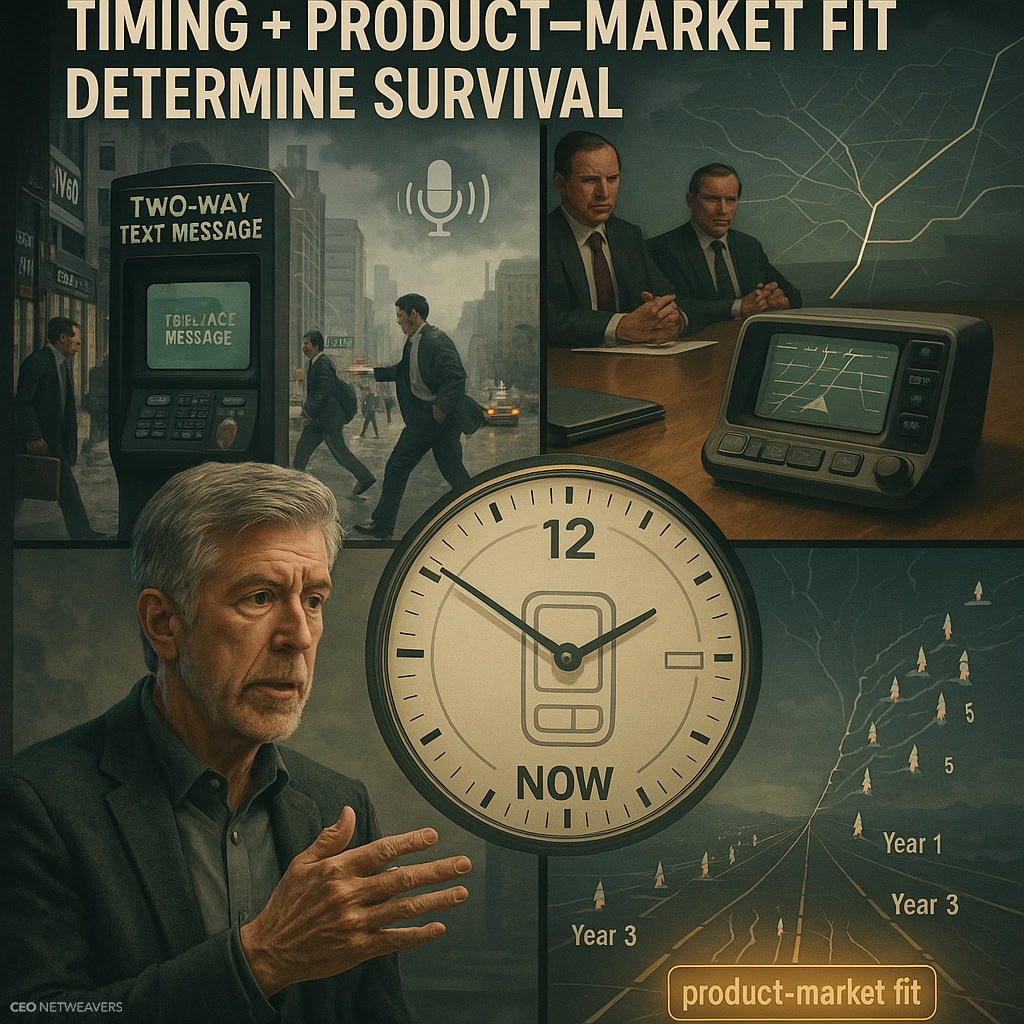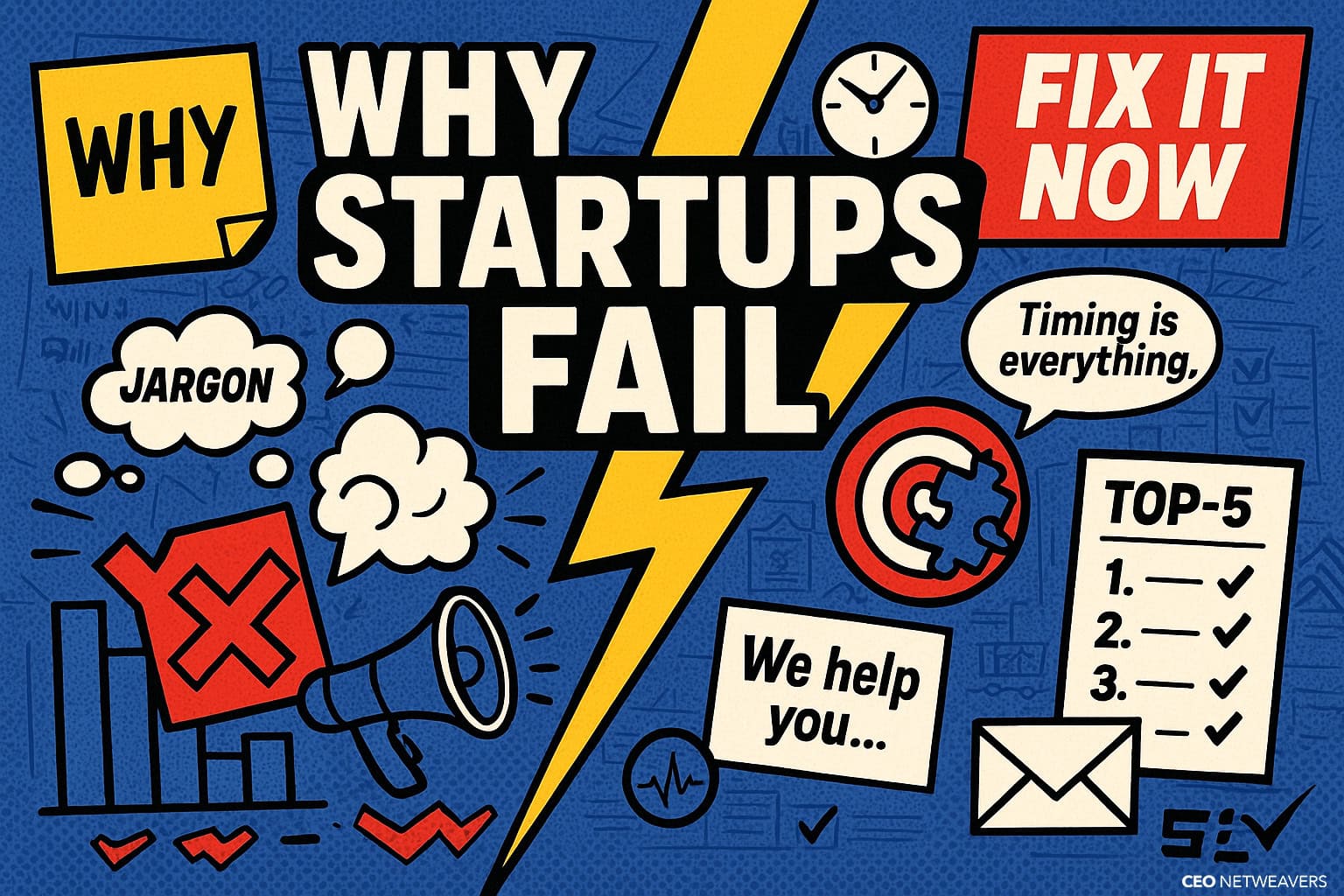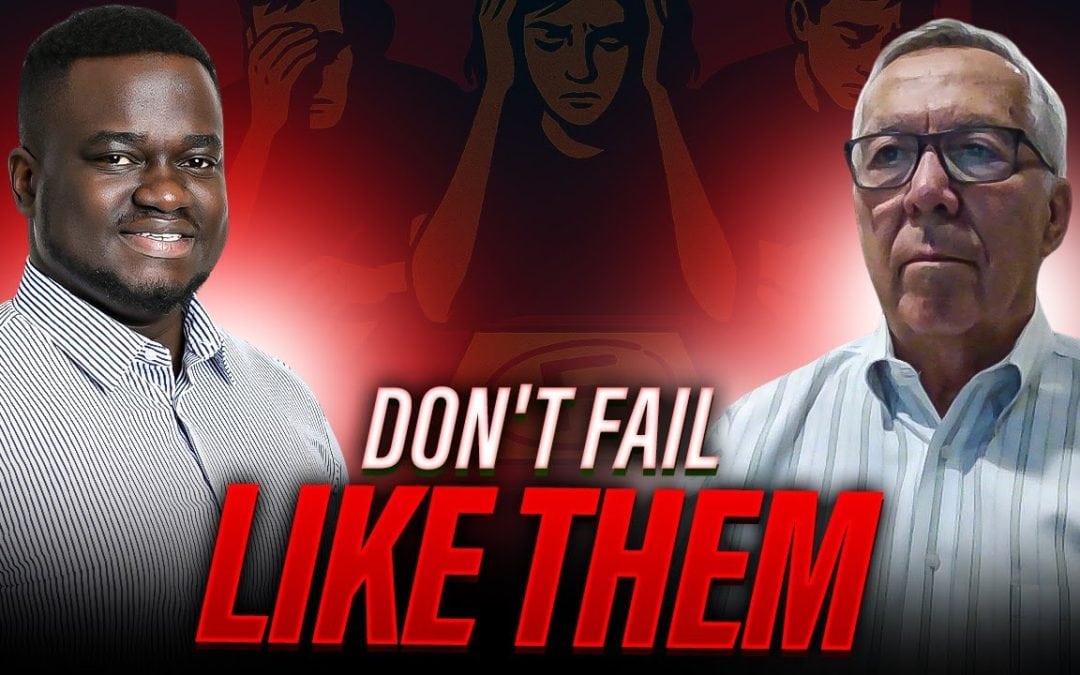Most startups don’t die because the product is bad. They die because the market isn’t ready, the problem isn’t urgent, or the message never lands. That is the hard truth—and the good news—because each of those is fixable with discipline.
On Creativity Boost Podcast, host Iredafe Owolabi and veteran operator Tom Berger cut through the noise. Berger’s career spans Motorola to six venture-backed CEO roles and 700+ practical articles on building companies.
His thesis is crisp: lack of product–market fit is the number one reason startups fail.
Everything else—pricing squabbles, feature requests, fancy demos—are symptoms, not root causes.
In his words, “timing is everything…having a great product and a great technology doesn’t do it if there’s not proper product market fit.”
As a growth executive and CMO who’s scaled GTM systems across B2B SaaS, marketplaces, and B2B2C platforms, I agree—and I’ll take it a step further. Startups fail when they skip three disciplines:
- customer discovery,
- message discipline, and
- “heartbeat” follow-up.
Nail those, and your odds of survival jump fast.
Tom has been a long-time member of CEO Netweavers, and this article walks through his and Iradafe’s most actionable lessons, then layers in the latest data and field-proven playbooks you can put to work this quarter.
The brutal baseline: most companies don’t make it (and that hasn’t changed)
The numbers are consistent over decades. Roughly one in five U.S. businesses fail in year one; about half don’t make five years; and roughly two-thirds are gone by year ten. That 10‑year survival curve has been stubbornly stable since the 1990s. (forbes.com)
Sectors matter at the margins, but not enough to save you from ignoring fundamentals. Even in industries with longer survival tails, the majority still don’t see their 10th birthday.
Takeaway for CEOs and investors: the failure rate is not a macro excuse—it’s a scoreboard. The teams that systematize discovery, fit, and communication earn compounding advantages while others chase features and “friend sales.”
The core diagnosis: product–market fit (and what founders get wrong)
Berger’s first principle mirrors what many of us teach our teams: the single biggest reason companies stall is the absence—or the erosion—of product–market fit. Andreessen popularized the frame nearly two decades ago, but it’s been refined since: fit is the degree to which your product satisfies strong, urgent demand in a definable market. It’s not binary, it decays over time, and “some interest” is not the same as “compulsion to buy.” (en.wikipedia.org)
- “In both cases, we had the product, but the market wasn’t ready…timing is everything.”
That’s what sank early two‑way texting in 1985 and in‑car navigation pitches in 1989 despite working tech. The market heat just wasn’t there yet.
Leaders tend to make three fit mistakes:
- Confusing solution desire with product demand (a false positive).
- Mistaking “friend-and-family” sales for market validation.
- Overweighting features vs. the single compelling reason to buy.
Each error is avoidable with disciplined discovery.
The three discovery stages that de-risk your roadmap
Berger outlines three stages: problem discovery, prospect discovery, and buying discovery. The structure aligns with Steve Blank’s customer development method—and it still outperforms in 2025 if you execute rigorously.
- Problem Discovery
Don’t “pitch and pray.” Interview to understand root causes, urgency, and current alternatives—without mentioning your solution. Ask fewer leading questions and far more “why” questions. The 5 Whys technique from Toyota’s lean playbook is simple, humbling, and devastatingly effective: keep asking “why” until you hit the root cause, not the first symptom. (en.wikipedia.org)
- Prospect (Persona) Discovery
Convert your raw notes into hypotheses: who feels the pain, who owns the budget, who blocks change? Validate with target prospects—then adjust until there’s agreement on the problem, stakes, and timing. The trap sign here is founders saying “yes, but…” when customers push back. That’s ego. The market is always right.
- Buying Discovery
Action beats opinion. When you put the offer in front of target accounts, do they buy? If not, why? If yes, why? That “why” reframes your entire pitch. Most teams learn their real value prop only after a few wins—if they ask and listen. As Berger puts it, “buying decisions are made in the heart, and then rationalized with features.” That aligns with decades of decision science and modern B2B research showing buyers seek confidence more than content. (gartner.com)
Operationalize this with a rolling discovery cadence (10–20 interviews per segment per quarter) and a living hypothesis doc the whole GTM org can see. Treat it as a product you iterate, not a one‑and‑done deck.

Messaging that moves deals: say less, say it better
You don’t earn product–market fit without message–market fit.
Berger advises a 12‑word elevator pitch that starts with “We help you…”. It sounds simplistic until you try it. The discipline forces you to answer the only question buyers actually care about: how will you help me, now?
Blaise Pascal’s old line captures the craft: if he’d had more time, he’d have written a shorter letter. Brevity is hard work—and it pays. When you compress your value to a memorable line, you become “sticky” in the buyer’s memory and inbox. The quote is real, from Pascal’s 1657 Provincial Letters (and yes, it’s often misattributed to Twain). (en.wikipedia.org)
Practical guardrails:
- Lead with the payoff, not the plumbing. Buyers buy outcomes; only the implementers care about the architecture.
- Strip jargon. Talk like a customer, not an engineer. If you must get technical, earn the right with a follow‑up doc.
- Optimize for recall. Your first sentence should be repeatable in a hallway conversation without slides or context.
Remember what the podcast emphasized: when sellers talk about patents, years in business, and internal processes, prospects mentally leave—even if they’re physically on the call. “The prospect is gone,” as Owolabi put it. He’s right.
The communication gap is widening: buyers self-educate and delay
Modern buying is messy. Gartner and Forrester data confirm what operators feel every week:
- 77% of B2B buyers say their latest purchase was complex or difficult, and nearly 90% of buying processes were stalled in 2023 due to budget pressure and information overload. (forbes.com)
- Buyers spend only a sliver of total buying time with any vendor; the majority of research is self-directed and influenced more by third‑party sources than by your own channels. (gartner.com)
- Digital commerce is now preferred by 83% of B2B buyers, yet it often increases purchase regret when it’s not paired with effective learning paths and confidence-building conversations. (gartner.com)
Implication: you must win the “invisible” part of the journey. That’s content, references, third‑party voices, and crisp, human copy that builds confidence without a rep in the room. It’s also why heartbeat follow‑up—more on that in a minute—converts delayed intent into booked revenue.
From “nice-to-have” to “buy-now”: position around urgency
The podcast hammered urgency with a memorable framing: even when you hear “that’s a real problem,” it may be number six—and the team only has resources for the top five. “Are you solving a problem prospects agree needs to be solved now and are willing to pay you for it?” That’s Berger’s first, eight‑part question, and it should be written above every product backlog.
You can increase urgency without gimmicks:
- Anchor on a critical job-to-be-done that’s failing today (e.g., “close month‑end two days faster” for a Controller, “prove channel ROI without UTMs” for a CMO).
- Quantify the drag cost in the buyer’s language (cash tied up, churn risk, SLA penalties).
- Make next steps small and safe (pilot with clear success criteria, not a six‑month contract).
- Time‑box value moments with natural deadlines (board meetings, renewals, audits) rather than artificial scarcity.
This is also where category expertise compounds.
When my teams at Showcase IDX and Sideqik focused messaging on the exact pains of real estate teams and brand/influencer marketers, we shortened cycles because prospects recognized their world immediately. That’s the point: make your message feel native to your buyer’s calendar, KPIs, and politics.
The “heartbeat” follow-up system (the quiet superpower)
Berger’s play that too many dismiss: heartbeat messages. After a first conversation, send short, relevant, personal notes that spark recall and create value—even if they’re not about your product. An industry benchmark, a case study, a regulatory change, a podcast clip. Keep it human: “Saw this and thought of your remark about warehouse shrink—look at page 6.”
Here’s why it works in today’s economy:
- Decision cycles are longer, committees are larger, and confidence is scarce. Staying useful keeps you top of mind when urgency arrives. (forrester.com)
- Buyers value third‑party interactions 1.4x more than vendor content. Your heartbeat can curate those third‑party proofs. (gartner.com)
- Drip at the account and the individual. Your contact may be sold, but procurement and finance need different proof.
Keep these messages short. One insight, one sentence on why it’s relevant, one ask if appropriate. That’s it.

Mentors over mirrors: outside counsel beats friend feedback
The podcast also calls out a painful reality: friends and family want you to feel good; a mentor wants you to get better.
There’s now scale evidence that structured mentoring correlates with higher business formation, job creation, and survival. SCORE—the SBA’s national mentoring network—reported helping start ~31,000 new businesses in 2023 and ~59,000 in 2024, with nine in ten mentored businesses staying in business, according to a third‑party analysis. (prnewswire.com)
For PE/VC-backed CEOs, “mentor” often means your operating partners or independent board members.
Both for PE/VC-backed and earlier stage CEOs, you can and should have an advisory board or a personal coach/mentor, with incentives tied to your company’s long-term success.
Use them. Have them review your discovery readouts, message spine, and pipeline loss analyses. If someone wants to charge you for surface‑level advice, move on. The quality you need is candid, pattern‑matched feedback from people who’ve carried a P&L—and ideally, missed a quarter and recovered.
From the field: the three questions Tom asks every founder
Berger offers three must‑answer questions. I’d adopt them, then add how I’ve seen leaders operationalize them inside GTM systems.
- Are we solving a problem prospects agree must be solved now—and will they pay us for it?
How to operationalize:
- Launch a “Top-5 or Bust” program. For every target role, instrument discovery to determine whether your problem lands in their top five priorities this quarter. If not, park the opportunity or reduce forecast weight.
- Deploy a short “Fit Test” survey after first call: ask buyers to rank the problem on urgency and business impact. Calibrate your deal strategy accordingly.
- Who is the buyer and the user—and what is their single compelling reason to buy?
How to operationalize:
- Enforce “one big idea per asset.” Every deck, one problem. Every landing page, one hero promise. Complexity kills recall.
- Post‑win interviews within 7 days. Ask “Why us? Why now? Why not someone else?” Then ask “why” again. Update your talk tracks weekly with what you learn.
- As competition appears, will the market be large enough to sustain our business?
How to operationalize:
- Establish a rolling “anonymous revenue” KPI (non‑referral, non‑friend wins). Celebrate it loudly.
- Track category creation vs. category capture. If you’re creating, budget more for education and third‑party enablement; if you’re capturing, compress the sales process around differentiation and risk mitigation.
The five mistakes that quietly kill good companies
- Premature scaling
Doubling paid spend before you’ve proven repeatable wins outside your network just amplifies noise. Fit before fuel. Know the difference between growth stage and scale stage.
- Obsessing over features, ignoring outcomes
No one buys features. They buy reduced risk, increased revenue, time back, and confidence. When you hear “we need feature X,” ask “to accomplish what job?” Then solve for the job.
- Talking like a vendor, not a peer
Boards don’t care how your algorithm works. CFOs want ROI math and downside protection. CISOs want assurance without effort. Earn each stakeholder’s trust in their language.
- Skipping disqualification
A “maybe later” is not a pipeline asset; it’s a calendar reminder. Disqualify respectfully, set a heartbeat cadence, and spend your cycles where urgency exists.
- Confusing activity with progress
Demos are not advances. Mutual action plans, confirmed champions, and budgeted pilots are advances. Everything else is theater.
Playbook: Install a discovery-to-revenue system in 30 days
Week 1: Instrument discovery
- Draft an initial problem hypothesis doc (roles, pains, current alternatives, “number six” risks).
- Build a 12‑question interview guide with at least five “why” probes. No pitching allowed. (en.wikipedia.org)
- Schedule 15 interviews with target buyers across segments. Include 5 non‑prospects to avoid confirmation bias.
Week 2: Message spine and 12‑word pitch
- Write your two‑line value spine: “We help [role] achieve [outcome] by [mechanism]. Result: [business impact].”
- Craft a 12‑word pitch starting with “We help you…” Test it live. Tighten until people can repeat it accurately the next day.
Week 3: Confidence content + third‑party proof
- Publish a concise, outcome‑first landing page. Ditch jargon. Add one proof point customers believe (customer quote, independent benchmark, or ROI math).
- Curate three third‑party resources buyers trust (industry reports, analyst notes, credible media). Buyers value this more than your own content. (gartner.com)
Week 4: Heartbeat system and buying discovery
- Launch heartbeat sequences for every active deal: one personal value‑add every 7–10 days.
- For every closed‑won, run a 15‑minute “why us/why now” interview within a week. Update your talk tracks and web copy with their words (not your copywriter’s).
Ongoing: Metrics that matter
- Top‑5 problem rate by role
- Anonymous revenue %
- Time to first value in pilot
- Win/loss segmented by “single compelling reason to buy”
For B2B SaaS, logistics, and marketplaces: turn these ideas into advantage
B2B SaaS
- Your users and buyers are different people. Build parallel messages: “We help RevOps reconcile attribution across channels without spreadsheets” for the user; “We pull forward pipeline and cut paid waste by 18% in 60 days” for the executive.
- Shorter contracts are the norm; your onboarding must deliver value inside the first 14–30 days or churn will climb. That means problem-based activation, not just feature tours. (dfnstrategy.com)
Logistics and supply chain
- Tie messaging to asset visibility, shrink, SLA penalties, and working capital. When Berger said, “We help you track your assets as they move from place to place,” that’s the pattern—simple, outcome‑first, role‑specific.
- Heartbeat content that wins: port congestion updates, policy shifts, and benchmark fill-rate data. You become the source they trust, not just another vendor.
Marketplaces and platforms
- Validate fit on both sides. Your demand story is useless without supply liquidity and vice versa. Discovery must include both personas and the moment of matching.
- Use third‑party credibility (ratings, case studies, and analyst quotes) early. Marketplaces are trust engines; design your copy to reduce perceived risk on day one. (gartner.com)
Real estate platforms
- Speak the language of teams and broker-owners: listing acquisition, agent productivity, IDX performance, and time to preapproval. Value moments here are hyper‑specific (e.g., “15% more on‑site inquiries from organic search in 60 days”).
- Invest in Enterprise SEO that maps to local intent and agent recruiting pages. Make it fast, human, and useful—no keyword soup.
What to do when you’re “number six” on the priority list
Being a real problem is not the same as being the next problem. If you’re consistently “number six,” you have three options:
- Reposition the outcome so it ladders to a top‑five priority. Example: you’re selling analytics; reposition it as “two‑day faster board reporting” or “audit‑ready revenue recognition.”
- Change the who, not the what. If a segment isn’t urgent, find a shoulder market that is. PMF often emerges when you switch the buyer, not the product. Andreessen and Rachleff have both underscored this over the years. (en.wikipedia.org)
- Narrow the first win. Shrink scope to a problem you can fix in two weeks with obvious impact. Small, undeniable wins change your internal rank.
If none of those bite, stop pushing the rope. Park the segment, maintain heartbeat touches, and reallocate capacity to where urgency lives.
When good products still stall: indecision and the confidence gap
Sometimes you’ve nailed fit and the message—and deals still linger. That’s not always a “sales skill” problem; it’s often a confidence problem on the buyer’s side. Forrester’s 2023 global survey found nearly 90% of business purchases were stalled, with price pressure and information overload as the main culprits. Your job is to make the choice safer and easier. (forrester.com)
What works:
- Price transparency and ROI math early, not just at proposal. (forrester.com)
- A mutual action plan that shows procurement, security, and finance their path with minimal friction.
- Third‑party validation (analyst notes, peer references) rather than more vendor content. (gartner.com)
In other words: reduce regret before it happens.
The small thing that changes everything: listen more, talk less
One line from the episode captures a culture I’ve tried to build on every team: “You have two ears and one mouth. Use them appropriately.” Sellers who probe with “why” and write down what they hear discover the truth faster. Those who rush to demo rarely do.
You can systematize listening:
- In discovery notes, force a one‑line “customer problem in their words” field. No internal jargon allowed.
- In enablement, coach reps to pause after objections and ask, “Can you say more about that?” It’s amazing how often the real blocker surfaces on the second sentence, not the first.
Berger’s call to action—plus one from me
Berger closed the podcast with a plug for deeper learning and a practical offer to “browse before you buy” his content. The spirit matters: be a student of the craft. “Most of the things are just common sense,” he admitted, “but common sense is not common practice.” He’s right.
My add: pair that learning with servant leadership. Great go‑to‑market systems are built by teams who listen, simplify, and make others successful—customers, partners, and colleagues. That’s how we scaled teams whose work ended up used by companies like Meta, Apple, Microsoft, and others. It wasn’t rhetoric. It was repeatable, humble, high‑tempo execution.
A concise checklist to keep on your desk
- Is the problem we solve in our buyer’s top five this quarter? If not, why not?
- Can every seller deliver our 12‑word pitch from memory, and can the buyer repeat it back a day later?
- What proof—ideally third‑party—builds confidence for each stakeholder today? (gartner.com)
- How many heartbeat messages did we send this week that weren’t about us?
- What did we learn from our last three wins and losses—and did we update the message and motion?
If you can’t answer those clearly, you’re operating on hope. That’s not a strategy.
Final thought
Failure rates are sobering, but they aren’t fate. The founders and operators who outlearn the market, communicate like peers, and follow up like pros build resilient companies—even in hard cycles. As Owolabi framed it, sometimes a “no” isn’t failure; it’s feedback. Use it.
Act on one thing today:
- Write your 12‑word pitch starting with “We help you…”
- Book five discovery interviews with zero pitching.
- Send three heartbeat emails that make a buyer’s day easier.
Then do it again tomorrow.
If you want a deeper dive on installing these systems across marketing, sales, and customer teams—or how we’ve applied them in B2B SaaS, logistics, marketplaces, and real estate platforms—reach out. Let’s make sure your company isn’t part of the two‑thirds that never see year ten.
Questions to Consider
Here are 10 discussion questions based on this podcast episode’s conversation that will help boost your leadership and accelerate your company, if you take the 5 minutes to ponder them.
- Tom Berger states that the number one reason startups fail is lack of product market fit. What examples did he share to illustrate this, and how might leaders better validate product-market fit early on?
- Berger outlined three essential questions every entrepreneur must answer to avoid “inevitable” failure. What are these questions, and how can executives use them to audit their own business opportunities?
- What is the difference between ‘problem discovery’ and ‘prospect discovery’ as explained by Tom Berger? How could leaders integrate these steps into their go-to-market motions?
- The episode highlights the danger of relying on friends and relatives for feedback. What alternative methods and resources did Tom propose for getting more objective guidance, and why is this critical?
- Tom mentioned ‘the five whys’ as a method for getting to the root cause of customer pain. How can organizations train their teams to actually use this approach rather than jumping to solutions?
- Berger talked about the trap of only selling to friends and family and running out of ‘anonymous’ customers. What operational steps should leaders take to make the leap from early adopters to a scalable market?
- How does Tom define a “buying customer discovery,” and why does he view the reasons for both wins and losses as equally valuable learning moments?
- Effective communication was flagged as a common stumbling block—even for companies with real market fit. What are Tom’s rules for concise messaging, and how might C-suite teams apply them to align internal and external communications?
- Berger distinguishes between information startups want to share and what prospects actually want to hear. How can senior leadership facilitate an organizational shift toward customer-centered messaging in both sales and product teams?
- Finally, Tom says finding the right mentor—one who won’t just “make you feel good”—can be the difference between success and failure. How should leaders select mentors or advisors, and what guardrails can help ensure they get candid feedback?
Memorable Iredafe Owolabi Quotes
- “Creativity is the ability to solve problems, but profitability is the ability to solve the right problem that people are willing to pay you for.”
- “Most creatives are creative but broke because they don’t know the nuances Tom is helping us unpack.”
- “There are people who know this product is for them… They just need help to see the value to having it at the moment.”
- “When your clients don’t buy, it’s not necessarily failure—it’s feedback that should trigger your creative thinking.”
- “All they wanted to hear was the payoff.”
Memorable Tom Berger Quotes
- “Timing is everything. Having a great product and a great technology doesn’t do it if there’s nothing proper product market fit.”
- “Failure is almost inevitable without answering three critical questions.”
- “The problem you think you’re solving is not the root cause of the problem.”
- “Creatives have great ideas, but they can’t make any money out of it.”
- “You run out of friends and relatives, and you don’t really have a great way of getting awareness in the general market.”
- “Don’t listen to your friends and relatives. Find a mentor.”
- “Focus really hard on that problem discovery to make sure you’re solving a problem your prospects agree needs to be solved now.”
- “So many people focus on what they want to say as opposed to what the prospect wants to hear.”
- “Elevator pitches should work in two story buildings and should be 12 words or less.”
Companies, Products, or Services Mentioned
- Motorola
- IBM
- Best Buy
- The big three automakers (implicitly refers to Ford, GM, Chrysler)
- CEO Netweavers
- CxO Atlas (Tom Berger’s online resource with articles and presentations
Speaker Bios
Tom Berger
Tom Berger is an accomplished startup advisor and business operator with decades of executive experience, including 17 years at Motorola where he launched major technology products like two-way text messaging and vehicle location systems. With a master’s in electrical engineering, Tom has led multiple venture-backed companies—some to notable success, others through the hard lessons of failure. He’s authored over 700 articles on business operations, startup growth, sales strategy, and organizational leadership, and currently coaches founders pro bono to help them avoid his past mistakes. Tom Berger is a member of CEO Netweavers.
Iredafe Owolabi
Iredafe Owolabi is the host of the Creativity Boost podcast, focused on unlocking actionable insights for entrepreneurs, creatives, and business operators. With a passion for helping listeners translate creativity into profitability, Iredafe brings on seasoned industry experts to break down complex topics around innovation, growth, and business sustainability. His engaging interview style bridges practical strategies with the real-world challenges faced by founders and leaders.











